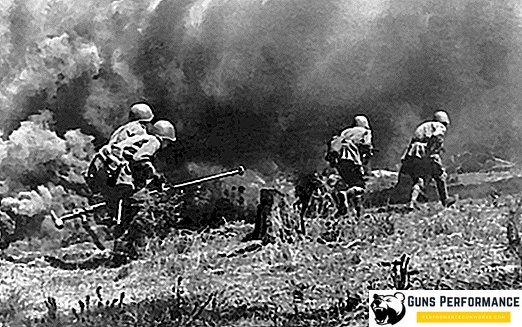You better chop wood for coffins -
Penalty battalions go to the breakthrough!
Vladimir Vysotsky

Among the huge number of tragic pages of the Second World War, the history of penal units occupies a special place. Despite the fact that more than 75 years have passed since the end of the war, disputes have not ceased around the penal battalions.
In Soviet times, this topic was not loved. It cannot be said that in the USSR they completely denied the existence of penal companies and battalions during the war, but historians could not get accurate information about the number of penalty boxes, their use at the front and the losses of such units.
In the late 80s, as usual, the pendulum swung in the opposite direction. A huge amount of materials on the penalty battalions began to appear in the press, films on this topic were made. Articles about the heroes of the penal battalions, which were shot in the back by NKVDshniki from the frontier detachments, became fashionable. The apotheosis of this campaign was the Shtrafbat series about the war, filmed by director Nikolai Dostal in 2004. Despite the good cast, one thing can be said about this work: almost everything shown in it is not true.
What is she, the truth about the penalty battalions? It is bitter and tough, exactly the same as the whole era to which this phenomenon belongs. However, there is no hopelessness in the subject of the penalty battles that opponents of the communist regime often portray.
The idea of creating penal divisions absolutely fit into the logic of the system, extremely rigid and inhuman, it did not cause any special accusations of injustice: to blame - redeem with blood. At that time, millions of Soviet citizens were erased into "camp dust" without any possibility of redemption.
By the way, in this respect, the Soviet punitive battalions and the fine punks can be called more “humane” than the Wehrmacht's punitive battalions — they know much less about them — they could only survive in a miracle.
In recent years, there have been some good research on this topic, the memoirs written by veterans who served in the penal battalions (Pyltsin "How the officer's fine battalion reached Berlin") appeared, and documentaries were made. Anyone can get objective information about this side of the war. We will also make our own possible contribution to this good cause.
Penalty: punishment and redemption
Penalty units are military units manned with military personnel who have committed some or other — usually not very serious — crimes. For serious offenses, the death penalty was usually relied upon, which was widely used in the Red Army and the Wehrmacht. Accordingly, the soldiers of the penal units are usually called penalty.
During the Second World War, there were two types of penal subunits in the USSR: penal battalions and penal companies. Approximately in the middle of the war — 1943 — separate assault rifle battalions were formed in the Red Army, into which soldiers and officers who had been in occupied territory for a long time were formed. The service in such units practically did not differ from the penal battalions; the practice of using them was similar. However, the assault battalions had some differences, which will be described below.
However, it should not be assumed that the penalty box is a Soviet invention: in Germany, penal units appeared before the start of World War II. Although the practice of using guilty soldiers in the most dangerous areas of hostilities is much older.
Penalties used in ancient Sparta, wrote about this ancient Greek historian Xenophon. Special units, consisting of deserters and draft dodgers, were also in the Great Army of Napoleon, who were encouraged by artillery fire to raise morale from behind.
In the Russian imperial army, the penal units were formed at the end of the First World War, in 1917. But at that time even such a measure could not save the situation at the front, penalty box did not take part in the battles and after a few months these units were disbanded.
Penalties were also used during the Civil War. In 1919, on the orders of Trotsky, penal companies were formed for deserters and criminal offenders.
In the USSR, the appearance of penal companies and battalions is associated with the famous order No. 227, which our military historians often call the order “Not one step back!”. It was published in July 1942, in the most difficult period of the war for the Soviet Union, when German units were torn to the Volga. It would not be an exaggeration to say that at that moment the fate of the country hung in the balance.
Penalty and penalty in the Red Army existed until the very end of the war, some of them actually managed to reach Berlin. The last punitive company was disbanded in June 1945.
Until the end of the war German punitive battles were used.

Soviet penal divisions
In the Red Army there were two types of penal subunits: a penal battalion (about 800 people) and penal companies (usually they had 150-200 fighters). During the entire war, there were only 65 separate penal battalions at the front (not all at once, but in general) and 1,037 penal companies. These figures can not be called accurate, since these units are constantly (about a few months) disbanded and re-created. From 1942 to 1945, only one single battalion, the 9th Independent Battalion, constantly existed.
Medium and senior commanders for non-binding military and criminal offenses were sent to the penal battalions. Sending to the penal battalion took place according to the verdict of the military tribunal, the sentence ranged from one month to three. All officers sent to penal battalions were to be demoted to private soldiers, their awards were transferred to the personnel departments for storage. Within one front, usually one to three penal battalions were created.
The soldier could leave the ranks of penalty box after the expiration of his sentence or by injury. The expression “to atone for one’s own blood” should be taken in the literal sense of the word: the wound received by the fighter even on the first day of his stay in the penal battalion returned him to his usual drill part in the previous position. There are cases when the front, on which the punishment battalion was located, did not take part in battles for several months and the military personnel, after serving their sentence, returned to their units again, never having participated in battles. Penalties who distinguished themselves in battle, could reduce the term of punishment. Sometimes they were even presented with awards.
Penalties were granted to the criminals who received injuries on the basis of their last salary. Relatives of the killed servicemen were paid cash benefits on a general basis.
Soldiers or military personnel of junior commanding officers got into the penalty companies. Usually in the army there were from five to ten such units. The rest of the penal company was not much different from the battalion.

It should be noted that the personnel of the penal divisions in the USSR were divided into two categories: permanent and variable. The permanent composition consisted of the battalion (company) command, including the headquarters of the unit, company and platoon commanders, political workers, medical orderlies, foremen, signalmen and scribes. So the commander of the penalty battalion (or finesproty) could not be a penalty box. The command staff of such units were given quite substantial benefits: one month of service was counted as six.
Now a few words about the personnel of the Soviet penal divisions. The officers got into the penal battalions, and civilians who committed these or other crimes could be sent to the punishment besides soldiers and sergeants. However, courts and military tribunals were forbidden to send people who were convicted of especially grave crimes (murder, robbery, robbery, rape) to a fine penalty. They could not get into such units and repeat thieves or people who had previously been brought to trial under especially grave articles of the Criminal Code. The logic of such actions is clear: professional criminals have a special psychology, which is not very compatible with the military service.
Political prisoners were not sent to the penitentiaries, which can also be easily explained: these people were considered "enemies of the people" who could not be trusted with weapons.
However, a large number of facts that have come down to us testify that experienced felons and people convicted under Article 58 still got into the penal units. However, this cannot be called a mass phenomenon.
The armament of the penal divisions was no different from what was used in combat units. The same can be said about food allowances.
How important were the penalty box
For the entire period of the Great Patriotic War, almost 430 thousand people passed through penal companies and battalions, while more than 34 million servicemen were drafted into the army. It turns out that the number of penal officers is just over one percent (1.24%) of the total number of servicemen of the Red Army. These figures completely refute the myth that the penalty units made a decisive contribution to the victory over Germany. The main truth about the battalions is that they made up only a small part of the Red Army.
True, the level of losses in the Soviet penal battalions exceeded the average level in ordinary combat units several times (3-6 times), and it was not easy to survive the penalty box.
Penal battalions and punitive charges were used to perform the most dangerous missions: conducting reconnaissance in force, delivering distracting attacks, and storming enemy fortified areas. During the retreat of the Red Army units, the penalty box often found themselves in the rear guard, covering the combatant units.
Often, similar tasks were performed by ordinary units, but the penal officers suffered heavy losses, because they were always sent only to the inferno.

Separate assault battalions
These units appeared in 1943. They were recruited by military personnel who visited the occupied territory: in captivity or in the environment. Taki people were considered unreliable, they were suspected of possible cooperation with the Germans.
In the assault battalions were sent for two months, while the military did not lose their rank, but even the officers in such units performed the tasks of ordinary soldiers. As in the penal battalions, the wound meant the end of the sentence, and the fighter was sent to the usual drill unit.
The use of assault units was similar to the use of penalties.
Wehrmacht penal battalions
In Germany, there were also penal divisions, moreover they appeared earlier than the Soviet ones, and their attitude towards military personnel was even more tough than in the USSR.
In 1936, the so-called Special Units were created in the Wehrmacht, to which servicemen were sent for various offenses. These parts are used to perform various construction and engineering works. To participate in the fighting, they were not involved.
After the victorious end of the Polish campaign, Hitler disbanded the German penal divisions, saying that now only those who deserve it will wear military uniforms. However, the campaign that began in the East forced the Reich leadership to reconsider this decision.

In 1942, the so-called five hundredth battalions (500th, 540th, 560th, 561st) were formed at the front, which were also called “test troops”. These units were very similar to the Soviet penal battalions, but the Germans treated them a little differently. It was believed that the person who committed the crime was given another chance to prove his love for Germany and the Führer. Soldiers sent to the 500th battalion were usually threatened with execution or concentration camp. So the penal baton was a kind of favor to him. True, very conditional.
The Germans, unlike the Red Army, wounded did not give a reason for the termination of punishment. From the 500th battalion could be transferred to the usual drill unit for valor in battle or the performance of some important task. The problem was that the translation was made according to the report of the commander, who was sent upstairs to the instances where he had been scrupulously studied. It usually took several months to consider the case, but they still had to live in the penal court.
However, despite this, the 500th battalions fought very desperately. The 561st battalion defended the Sinyavino heights near Leningrad, which cost the Red Army a lot of blood. Paradoxically, sometimes the 500th battalions performed the functions of detachments, supporting the rear of unstable divisions. More than 30 thousand troops passed through the German penal battalion.

There were field units in the Wehrmacht, in which they were recruited directly in the combat zone and immediately applied.












